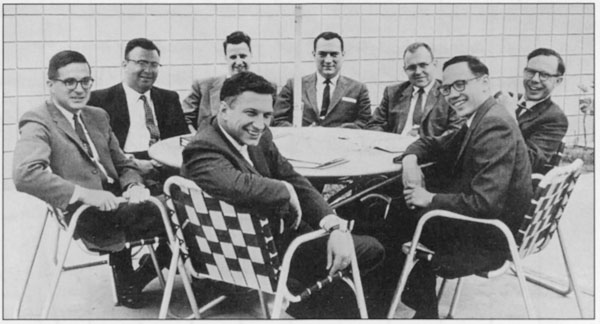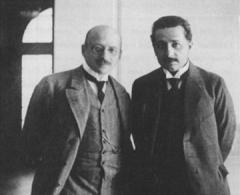
This Article From Issue
November-December 2005
Volume 93, Number 6
Page 558
DOI: 10.1511/2005.56.558
The Man Behind the Microchip: Robert Noyce and the Invention of Silicon Valley. Leslie Berlin. xiv + 402 pp. Oxford University Press, 2005. $30.
The 1957 picture below shows eight young men, the cofounders of Fairchild Semiconductor Corporation, gathered around a table outdoors in northern California. At front and center is Robert Noyce: handsome, charismatic, yet easygoing, the epitome of the entrepreneurial spirit that would help shape postwar, high-tech America.
Noyce, the son of a minister, attended Grinnell College and then got a doctorate in physics from MIT. Two years later, in 1955, he moved to California to join a company in Palo Alto that had just been started by William Shockley, one of the coinventors of the transistor. Shockley's remarkable eye for talent was exceeded only by his gift for mismanagement. Less than two years later, the men in the photograph, who had all worked for Shockley—the "Traitorous Eight," he named them—were dissatisfied enough to strike off and found their own company: Fairchild Semiconductor. There Noyce invented the integrated circuit (at about the same time that Texas Instruments engineer Jack Kilby also produced one). And he quickly rose to the rank of general manager. A decade later, Noyce and Gordon Moore left Fairchild to start a second company, Intel, which became a leader in the semiconductor industry in the 1970s and 1980s.

From The Man Behind the Microchip.
The outlines of Noyce's life and work are fairly well known. Still, Leslie Berlin's excellent new study, The Man Behind the Microchip, is a welcome addition to the body of historical literature dealing with recent computer technology. The book is one of only a handful of scholarly biographies of members of the generation of inventors and entrepreneurs who were attracted to California in the 1950s and 1960s, built the semiconductor industry and helped create the economic and cultural phenomenon now known as Silicon Valley.
Berlin describes Noyce's technical accomplishments accurately and with appropriate detail, but she also makes clear that he was as much a social and economic innovator as a technical one. For example, the strategy he developed at Fairchild of regularly cutting the price of company products was seen as crazy at the time but has since been widely adopted in the high-tech industry. Also, Noyce insisted on extending stock options to nearly everyone in his companies. The fact that Sherman Fairchild's criticism of the move as "socialism" sounds so strange today shows how much Noyce's innovation changed business.
Berlin's portrayal of Noyce might be characterized as ironic hagiography. She celebrates his achievements as coinventor of the integrated circuit and as a serial entrepreneur, but she also makes it clear that those accomplishments came at a substantial human cost. Noyce's first wife filed for divorce after their children—several of whom struggled with problems as adults—caught him in flagrante delicto with a coworker. He was not the most effective executive, but the long-term consequences of his missteps were more good than bad. His decision to leave Shockley Semiconductor to set up a competing company was considered ungentlemanly at the time, but it helped establish what is now a familiar pattern in Silicon Valley and turned job mobility into a virtue. (AnnaLee Saxenian argues in her now-classic work Regional Advantage that this pattern helped vault Silicon Valley ahead of Boston's Route 128, where more emphasis was placed on company loyalty.)
Under Noyce's leadership, Fairchild's fortunes were uneven, and at times the company hemorrhaged talent. These losses seemed a bad thing at the time, but as a result Fairchild alumni were founders of or senior employees in every semiconductor company in Silicon Valley in the 1960s (the spinouts were known as the Fairchildren). Thus the industry developed a collective identity that transcended daily competition.

From The Man Behind the Microchip.
Berlin also notes that at several critical points in his career Noyce received sole credit for what were in fact ensemble achievements. He became more famous than Fairchild colleagues who contributed much to the success of the integrated circuit—although this inappropriate allotment of credit happened not through his own self-promotion but because the company needed to put a public face on its legal claims to the patent on the integrated circuit.
Fifteen years later, Intel built its reputation by capitalizing on Noyce's telegenic personality, at the expense both of Noyce's friend Gordon Moore and of the company's head of research and development, Andy Grove. Noyce loved the spotlight, but the spotlight loved him more. Noyce's modest, "aw-shucks" manner made him a more approachable leader and gave his companies a friendly, human face. Indeed, Berlin's biography shows that marketing, although we tend to think of it as less important than engineering and management, deserves more attention in histories of Silicon Valley. It is no coincidence that Regis McKenna, the man most responsible for shaping the region's approach to high-tech marketing, started his career at Intel.
Ironically, Noyce is now less well known in some circles than the colleagues he once eclipsed. Eugene Kleiner, another of the Traitorous Eight, founded one of the world's leading venture capital firms. The immortality of Gordon Moore (another of the eight) is guaranteed by Moore's Law, which predicts that both the size and cost of transistors will shrink steadily and rapidly. Andy Grove led Intel through its explosive growth and the "Intel Inside" campaign that made the company a household name. Noyce himself died in 1990, ten years before the Nobel Prize committee got around to recognizing the invention of the integrated circuit by awarding the 2000 Prize in Physics to Jack Kilby. Noyce would probably have shared in it if he had still been alive, but the Nobel is not awarded posthumously. Integrated circuits are themselves so ubiquitous it's hard to imagine them having had an inventor. It's like someone claiming to have invented bricks or woven cloth. So Berlin's biography will help preserve Noyce's reputation and will serve as an important resource for future studies of Silicon Valley.

American Scientist Comments and Discussion
To discuss our articles or comment on them, please share them and tag American Scientist on social media platforms. Here are links to our profiles on Twitter, Facebook, and LinkedIn.
If we re-share your post, we will moderate comments/discussion following our comments policy.